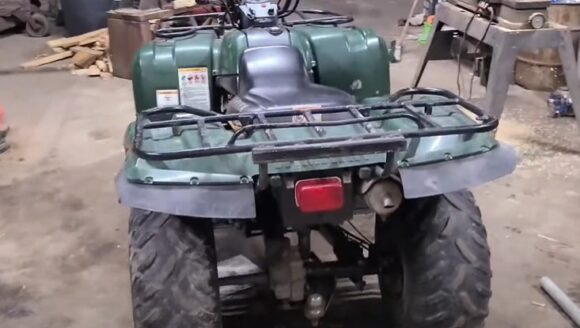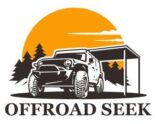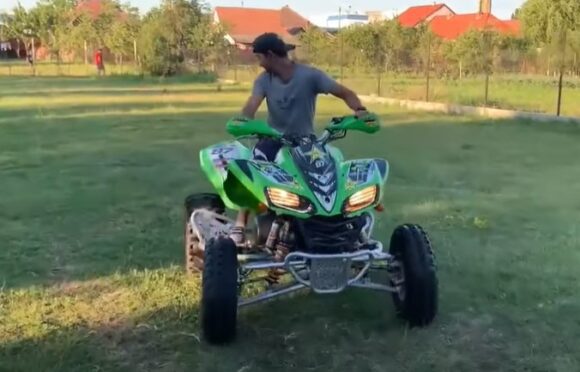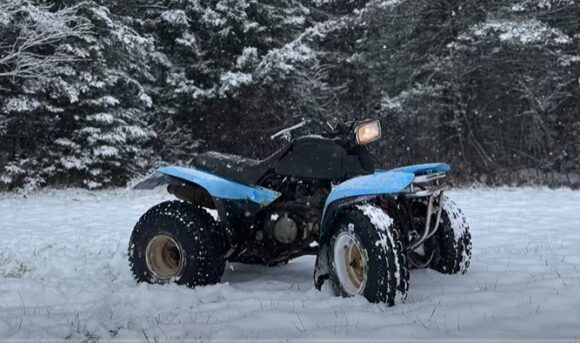The 17th model to be made available for commercial use, the Yamaha Big Bear 400, uses the same language as its predecessor from the 350-class of 1987. But the ATVs shows some common troubles you should know about.
The most common Yamaha Big Bear 400 problems are frequent issues with the carburetor, difficulty in starting, front brakes getting stuck, bogs at the middle throttle, and gas in the airbox.
Several of the typical Yamaha Big Bear 400 issues will be discussed in this article, along with their solutions.
Yamaha Big Bear 400 Problems

These are the most common symptoms of Yamaha Big Bear 400 problems:
1. Frequent Issues with Carburetor
A few customers complained about the 2003 Yamaha Big Bear 400’s carburetor problem. They expressed dissatisfaction because one of the needles was entirely gone.
Additionally, a malfunctioning carburetor might cause the automobile to operate poorly after being idle for almost a year.
This problem also arises from infrequent carburetor cleaning.
The metal parts of the carburetor can corrode if they are exposed to moisture or old petrol, which might result in leaks, blockages, or additional issues.
The fix
You might have to swap out a damaged needle valve with a new one in order to fix it. To reach the needle valve, you must first take the carburetor out of the engine and disassemble it.
The needle valve may be found on the float or in the float bowl, depending on the carburetor.
You might need to completely replace your carburetor if it is seriously defective or cannot be fixed.
Make sure the replacement part you purchase is an accurate one for your model of Yamaha Big Bear 400.
2. Difficult to Start
Customers claim that the ignition system of the Yamaha Big Bear 400 from the 1998 model year has certain troubles. They criticized the starting motor for not spinning quickly enough. A defective solenoid may be the cause of this.
Additionally, the Yamaha Big Bear from the 2007 model year has trouble starting.
This often occurs as a result of a starting-related issue, which might be a starter fuse, relay, or solenoid.
The wiring for the start circuit may potentially be harmed. It’s also possible that the battery voltage is too low to power the starting motor. Alternator or battery problems are also possible.
The fix
If the starting motor is given adequate force, the problem can be resolved. Test and adjust the power that the solenoid should be putting out.
Pulling the motor to start can also address the problem; if it starts and operates without any issues, the problems are generally solved.
Make sure the wires coming from the start button are intact by checking them twice, then follow them to look for a 1″ cubed black box.
Find the starter and check sure it remains in place.
3. Front Brakes Get Stuck
According to consumers, the braking system of the Yamaha Big Bear 400 from the 1998, 2000, and 2003 model years has problems.
For instance, the front brakes won’t activate until the brake handle is mostly pushed in.
After a while of riding, the Big Bear’s front brakes lock up.
Braking system problems can occasionally be brought on by the need to rebuild the master cylinder or by a malfunctioning flexible hose.
The fix
From the master cylinder to the calipers, check and, if necessary, replace all of the brake lines. In order to lessen the problem, try rebuilding the master cylinder.
O rings for the caliper should be changed as well.
The master cylinder’s braking fluid level should be checked first. It will not operate correctly if it is low. Therefore, as directed in the instruction, add brake fluid to the proper level.
4. Bogs at Middle Throttle
The middle throttle on Yamaha Big Bear models from 2000 frequently malfunctions. Fast acceleration causes it to stammer, bog down, and die until the throttle is released.
When the throttle is pushed, an old or defective gearbox may cause the engine to bog.
Additionally, a malfunctioning throttle position sensor may provide false information to the engine control unit, slowing it down.
The fix
This issue is mostly caused by a malfunctioning throttle position sensor (TPS), which may need to be replaced.
This entails unplugging the previous TPS and setting up the new one. Use the appropriate replacement component for your engine.
Check and fix the fuel delivery system; if the fuel filter, fuel pump, or fuel lines are broken or clogged, they may need to be replaced.
5. Gas in Air Box
Some customers reported that there is a strong gas smell coming from the air box when the car won’t start on occasion.
This may be because the needle is stuck or out of sync, or there may be a blockage in the vent line.
When the valve lash is off, this issue may occasionally occur.
Unfiltered air entering the engine through a broken or damaged air box can harm the engine and decrease performance.
The fix
When you notice a strange odor, check the air intake hose to see whether it is disconnected or loose. If so, you may reconnect it or replace it with a new one.
Making sure that the new hose is the appropriate size and kind for your Yamaha Big Bear 400 is vital.
In the first place, it’s crucial to frequently check and maintain the air box.
This involves inspecting the air filter, cleaning it if necessary, and examining the air intake hose and air box for wear or signs of damage.
Which Year Yamaha Big Bear 400 Has the Most Problems?
Customers claim that among the other models, the 1998 and 2003 Yamaha Big Bear 400 is known to have the most significant issues.
The most common problems experienced by Yamaha Big Bear 400 consumers in recent years are carburetor malfunction and braking problems.
The 1998 Yamaha Big Bear 400 has a variety of issues, including the fact that it can be challenging to start up at times.
Customers claim that the vehicle frequently has this problem, which is mostly brought on by malfunctioning parts.
Numerous well-known problems with the 2000 Yamaha Big Bear 400 include a defective air filter and bogging towards the middle of the throttle.
The root cause of problems like these may be due to abuse and poor maintenance of the vehicle.
Tips for Buying a Used Yamaha Big Bear 400
Due to its adaptability and endurance, the Yamaha Big Bear 400 is a dependable and potent ATV that is well-liked by outdoor lovers. But there are some things with which you need to be cautious.
Check the condition of the carburetor first to ensure it is in good working order.
Verify the air box and front brakes used in the ATV. Especially if you’re purchasing a previously owned vehicle, please use more caution when buying one.
Yamaha Big Bear 400 Users Feedback/Reviews
Technical Aspects of Yamaha Big Bear 400
| Specifications | Yamaha Big Bear 400 |
|---|---|
| Engine Type | 4-stroke, air-cooled |
| Engine Displacement | 386 cc |
| Bore x Stroke | 83 mm x 71.5 mm |
| Compression Ratio | 8.6:1 |
| Carburetion | Mikuni BSR33 |
| Ignition | DC-CDI |
| Starting System | Electric |
| Transmission | 5-speed with reverse |
| Drive Train | 2WD/4WD |
| Front Suspension | Independent double wishbone, 6.3 inches of travel |
| Rear Suspension | Swingarm, 7.1 inches of travel |
| Front Brakes | Dual hydraulic disc |
| Rear Brakes | Sealed drum |
| Front Tires | AT25 x 8-12 |
| Rear Tires | AT25 x 10-12 |
| Length | 77 inches |
| Width | 45.5 inches |
| Height | 45.3 inches |
| Wheelbase | 48.4 inches |
| Ground Clearance | 7.1 inches |
| Fuel Capacity | 4.0 gallons |
| Wet Weight | 635 lbs |
| Colors Available | Realtree Edge, Hunter Green |
| Warranty | 6 months limited |
Suzuki King Quad 750 vs Yamaha Grizzly 700


